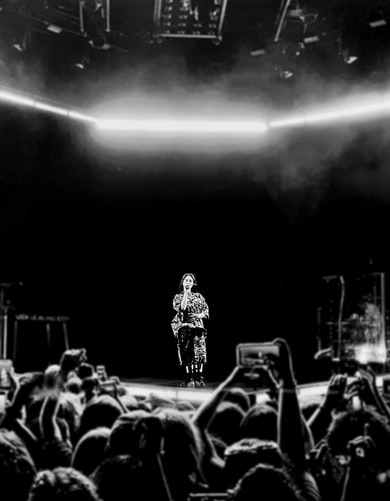Anytime a female actress is on screen, more importance and attention is given to her physical features rather than her actual personality. From films to televisions shows to music videos, any form of entertainment focuses quite a bit on what a woman looks like rather than how she is.
What creators and perpetrators of the male gaze fail to understand is that their work can have consequences that go far beyond just the screens of our televisions and phones.
What is the Male Gaze?
The term “Male Gaze” was coined by Laura Mulvey a feminist film theorist from Britain in the year 1975. She discussed the theory of sexually objectifying women in media from a heterosexual man’s pint of view in her renowned essay Visual Pleasure and Narrative Cinema. For a majority of the entertainment industry, women are shown as docile objects of male desire. In terms of the psychological reasoning behind the male gaze, it is similar to the Freudian concept of scopophilia – the pleasure of looking.
Mulvey is a prominent film theorist in the industry and her ideas bring awareness to cases of clear misogyny in films and other forms of media. Her theory has allowed people to start questioning gender roles in films and how they propagate false realities in the name of fiction. It has been decades since she called out films and media for their wrongdoings, yet our entertainment industry still thrives on sexually objectifying women and placing them in traditional roles.
“…the gender power asymmetry is a controlling force in cinema and constructed for the pleasure of the male viewer, which is deeply rooted in patriarchal ideologies and discourses,” says Mulvey.
A majority of these scenes are targeted towards a male audience and so everything is catered to their liking. The root cause for this issue stems from a male-driven society that views women as their property and inferiors. This theory that Mulvey developed and studied is just as relevant in the 21st century as it was in 1975.
According to her, the roles that are written for women are often meant to simply bear meaning. They characters never take a control of a scene as they are seen as mere embellishments. Their purpose to just stand in the frame and look pretty while the men in that room and in the audience gawk at them to please themselves. What frustrates me so much about this concept is that the roles are never really reversed. It is quite rare to see men in the same position. And this disparity just goes on to reinforce the idea that women are eye-candy and men have the right to treat them like that.
The audiences suffer along as they are forced to see women from the male gaze too. Audience members like heterosexual women or homosexual men, for instance, may feel uncomfortable to see the female characters portrayed in such a degrading manner.
Examples of the Male Gaze in Media
Typical examples of the male gaze tend to strip the female characters of their human identity. She is simply an object, a prop, of heterosexual male desire. And if you were to remove these female chapters all together, the plot wouldn’t be affected much.
“Her feelings, thoughts and her own sexual drives are less important when compared to the male counterparts, which often sees the female characters being almost invisible in the narrative.”
Bianca Garner, intheirownleague.com
I am going to ask you to pause for a second and think of the last movie or show or music video you saw and how the female actresses were portrayed in that medium. What was the point of view? What parts of the women were given the most screen time?
“Visual media that respond to masculine voyeurism will tend to sexualize women for a male viewer as well as the male characters being depicted on the screen,” says Garner.
Mulvey wrote that in media, a woman is a spectacle and the man is “the bearer of the look.” Let’s look at the 2005 film The Duke of Hazard, for instance, when Daisy Duke (Jessica Simpson) enters the scene in a long trench coat only to remove it to reveal nothing but a pink bikini underneath. This scene is a wide shot, so Daisy’s entire body on display for the male characters and the male audience. As she walks towards the camera, it is almost as if she is breaking the fourth wall, essentially giving the male audience to stare at her all they want.
Now some of you may be thinking that men go through the same in shirtless scenes and such. But let me stop you right there. A shirtless scene of a man is not always about the female audience. It is about the man being proud of his body and looks because he believes that women, much like most men, only care about the physical appearance of their partner. For the shirtless man, he knows what he is doing and the affect it has on those around him. Despite being shirtless or even naked, he will still be in control over his female counterpart in that scene. For women, that is not the case because they are presented as objects.
Mulvey argues, “the male figure cannot bear the burden of sexual objectification. Man is reluctant to gaze.”
Just take Patty Jenkins Wonder Woman as an example. There is a scene where Chris Pine’s character Steve Trevor is naked on screen, but there is an important reason behind it. In this scene Trevor’s nudity is a part of the plot as he is still activity participating in the scene. Unlike Daisy Duke, he is not breaking the fourth wall by putting himself on display.
Especially when it comes to action based films like James Bond and Transformers, the female characters no matter who they are are viewed from the male gaze. The female protagonists, specifically, are referred to as the “fighting fuck toy” trope. This term was coined by Caroline Heldman and it refers to hyper-sexualized female protagonists who fight alongside the male protagonists.
“The FFT appears empowered, but her very existence serves the pleasure of the heterosexual male viewer, says Heldman. “In short, the FFT takes female agency, weds it to normalized male violence, and appropriates it for the male gaze.”
Outside the Big Screen
While we have become more aware of the male gaze and the disgusting ideas it propagates, we are also equipped with enough knowledge to not buy into it. It is sad to say that such depictions of women are a normal part of out popular culture and society. Cat calling, staring at women in public transportation, gawking at women in line, “accidentally” touching women inappropriately, etc. All of these are unconsciously inspired by the male gaze portrayed on screen.
And we are just scratching the surface because there is still so much to discover and understand about the male gaze. Do we redefine the male gaze, if so how? What is the female gaze look like then? Does the gaze change based on the race of the receiving character?
Interested in more entertainment content?




